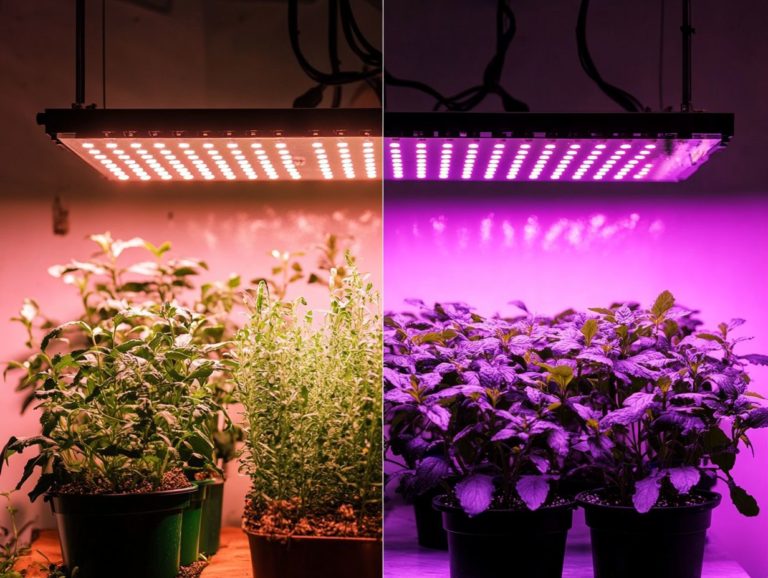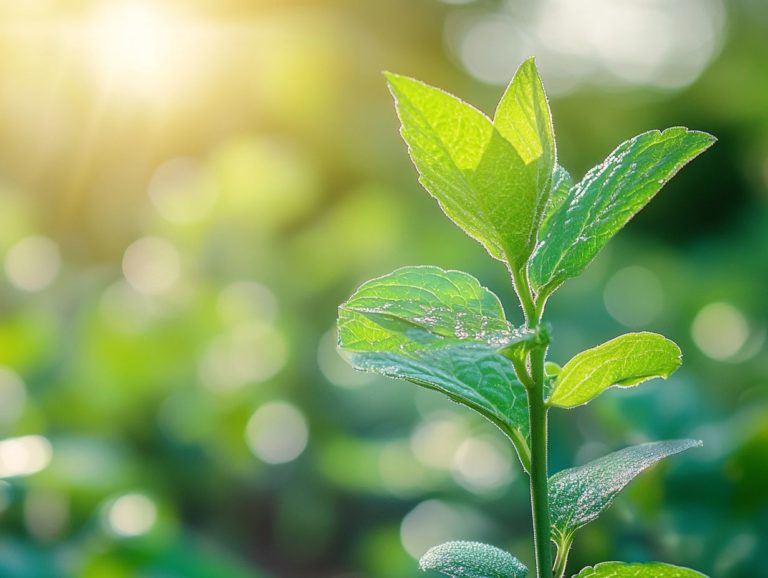Understanding the Photosynthesis Process
Photosynthesis is a remarkable process that sustains life on Earth. It transforms sunlight into energy for plants while releasing oxygen gas a vital resource for countless living beings.
This article delves into the intricate stages of photosynthesis, highlighting both the light-dependent and light-independent reactions, along with the crucial role of chlorophyll pigment. You’ll discover how various environmental factors influence this essential process and its significance for both plants and humans alike.
Join in as you uncover the wonders of photosynthesis and explore its vital applications in your world.
Contents
Key Takeaways:

- Photosynthesis is the process by which plants convert light energy into chemical energy to produce food and oxygen.
- The two stages of photosynthesis are light-dependent reactions and light-independent reactions (Calvin Cycle).
- Chlorophyll plays a crucial role in photosynthesis by absorbing light and converting it into energy, while also giving plants their green color.
What is Photosynthesis?
Photosynthesis is a fascinating biochemical process employed by organisms that produce their own food, like plants, algae, and certain bacteria. It transforms light energy into chemical energy, specifically through the formation of glucose molecules.
This process not only creates glucose but also enriches our atmosphere with oxygen. Oxygen is crucial for sustaining life on Earth and enhancing ecosystem productivity.
Stages of Photosynthesis
The two primary stages of photosynthesis are the light-dependent reactions and the light-independent reactions, often referred to as the Calvin cycle. These processes unfold within the thylakoid membranes and the stroma of chloroplasts, respectively.
During the light reactions, light energy is transformed into chemical energy, producing ATP and NADPH. These molecules are vital for the subsequent light-independent reactions, where carbon dioxide is fixed into glucose, fueling life as we know it.
Light-Dependent Reactions
Light-dependent reactions kick off the remarkable process of photosynthesis, taking place within the thylakoid membranes of chloroplasts. Here, chlorophyll absorbs light energy, sparking a fascinating series of chemical reactions.
As this unfolds, chlorophyll molecules capture photons, exciting electrons and sending them on an exhilarating journey through the electron transport chain. This movement is pivotal, transforming light energy into chemical energy, ultimately leading to the synthesis of ATP and NADPH.
ATP is generated through a process known as photophosphorylation, where light energy helps add a phosphate group to ADP to make ATP. Concurrently, NADP+ is reduced to become NADPH, a key player in the Calvin cycle.
These energy carriers are essential, fueling the next stages of photosynthesis and turning light into the energy required for plant growth and metabolism.
Light-Independent Reactions (Calvin Cycle)

The Calvin cycle, or light-independent reactions, unfolds in the stroma of chloroplasts, where carbon dioxide is ingeniously converted into organic molecules through a series of intricate chemical reactions, ultimately culminating in the creation of glucose.
This captivating process kicks off with the enzyme Rubisco, which plays a pivotal role in carbon fixation by capturing carbon dioxide directly from the atmosphere. As the cycle advances, ribulose bisphosphate (RuBP), a five-carbon sugar, undergoes transformation through a meticulously orchestrated series of reactions, producing three-carbon molecules called glyceraldehyde-3-phosphate (G3P).
Some of these G3P molecules are then cleverly repurposed to synthesize glucose, which is essential for the growth and development of plants. This cycle not only benefits plants but also plays a critical role in sustaining the ecosystem by providing foundational support for food webs and underscoring its importance in energy storage, biomass productivity, and ecological balance.
Get ready to explore the hidden wonders of photosynthesis and consider its importance in your daily life!
The Vital Role of Chlorophyll in Photosynthesis
Chlorophyll is a vital green pigment found within the chloroplasts of plant cells. It plays an essential role in photosynthesis by expertly absorbing light energy, particularly from the blue and red wavelengths.
This absorption is crucial for the light-dependent reactions that occur in the thylakoid membranes. These reactions drive the entire process of converting sunlight into the energy that sustains life on Earth.
How Chlorophyll Affects Photosynthesis
Chlorophyll influences the efficiency of photosynthesis by affecting both the rate of light absorption and energy transfer within the plant. This impact is vital for overall plant productivity and biomass.
This essential pigment does more than capture sunlight; it is fundamental to the intricate interactions within photosynthetic pathways. These interactions ensure that energy is transformed into usable chemical forms.
As environmental conditions shift such as changes in light intensity or nutrient availability chlorophyll concentration can adjust, affecting how effectively plants harness solar energy.
When chlorophyll levels are high, expect enhanced photosynthetic rates, especially in optimal conditions. Conversely, limitations in light or nutrients can cause a decline in chlorophyll content, stifling energy transfer and hindering plant growth and yield.
Factors Affecting Photosynthesis
Photosynthesis is influenced by various factors, including environmental conditions like light intensity, temperature, and carbon dioxide levels.
Nutrient availability also plays a crucial role, along with the proper functioning of stomata for gas exchange. Together, these elements dictate plant productivity and overall biomass.
Environmental Factors and Their Impact

Environmental factors such as light intensity, temperature, and carbon dioxide concentration significantly influence the rate of photosynthesis in plants. Stomata play a vital role in gas exchange processes.
When light intensity increases, you ll often see a corresponding rise in photosynthetic activity, leading to greater glucose production. This assumes that other conditions, like water availability, are also optimal.
High temperatures can initially boost photosynthesis, but there s a tipping point beyond which enzymes break down and stop working, leading to decreased efficiency. As carbon dioxide levels rise, the rate of photosynthesis may increase, as plants capitalize on this essential gas.
If any of these conditions stray from their ideal ranges, the entire process can be significantly hindered. This underscores the delicate balance necessary for optimal plant growth.
Applications of Photosynthesis
Photosynthesis is of paramount importance for both plants and the environment. It acts as the cornerstone for energy resources.
Importance for Plants and the Environment
Understanding photosynthesis is key to appreciating the incredible dance of life on Earth. It transforms light energy into chemical energy, creating biomass that fuels ecosystem productivity while releasing atmospheric oxygen that sustains myriad life forms.
This remarkable process supports the growth of individual plants and forms the foundation of entire food webs. Herbivores thrive on this biomass, which subsequently supports carnivores and omnivores.
The biomass generated acts as both habitat and a vital source of nutrition for countless organisms, enhancing the resilience of ecosystems. The oxygen released during photosynthesis is essential for maintaining the balance of gases in the atmosphere, enabling respiration for both animals and humans.
In this interconnected web of life, the health of terrestrial and aquatic ecosystems relies heavily on the efficiency of photosynthesis. This underscores its significance in combating climate change and nurturing biodiversity.
Human Uses of Photosynthesis
You harness the remarkable process of photosynthesis in agriculture and renewable energy. Its ability to produce food and biomass through the process of capturing carbon is vital for sustaining human populations.
This extraordinary process not only bolsters traditional farming practices but also plays a key role in developing biofuels. Biofuels provide a sustainable alternative to fossil fuels. By converting sunlight, water, and carbon dioxide into glucose, crops yield substantial biomass that can be transformed into various forms of energy, significantly reducing greenhouse gas emissions.
The efficiency of photosynthesis directly impacts food production, influencing crop yields and food security. Advances in agricultural technology, including genetically modified organisms (GMOs) and optimized farming techniques, aim to enhance this natural phenomenon. This ultimately benefits your welfare through increased productivity and sustainable resource utilization.
Frequently Asked Questions

What is photosynthesis?
Photosynthesis is the process by which photosynthetic organisms, including plants, algae, and some bacteria, convert sunlight, water, and carbon dioxide into glucose molecules and oxygen gas.
Why is photosynthesis important?
Photosynthesis is essential for life on Earth! It provides the oxygen we breathe and powers most ecosystem productivity.
How does photosynthesis work?
During photosynthesis, plant cells use specialized structures called chloroplasts to absorb sunlight. This energy is then converted into chemical energy through a series of reactions involving water and carbon dioxide.
What factors affect the rate of photosynthesis?
The rate of photosynthesis can be affected by factors such as light intensity, availability of water and carbon dioxide, and temperature. All these elements are critical for maximizing energy transfer and overall biomass productivity.
Can photosynthesis occur at night?
No, photosynthesis requires sunlight to take place, so it only occurs during the daytime when light waves are available. However, some plants, like cacti, have adapted to use a method to make food at night to conserve water.
How does photosynthesis contribute to the Earth’s carbon cycle?
Through photosynthesis, plants absorb carbon dioxide from the atmosphere and use it to produce glucose. This process helps regulate the amount of carbon dioxide in the atmosphere, playing a vital role in the Earth’s carbon cycle and contributing to carbon fixation.






